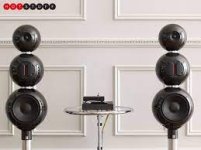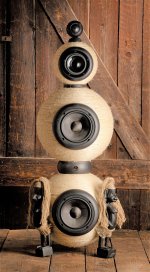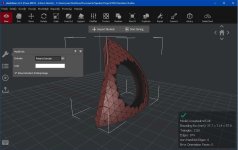Guilty here...There has to be a way to seal the enclosure from the outside leaking in, yet isolating the driver from the enclosure so some sort of seal that accomplishes both is needed at the driver mounting and where the foot exits the cabinet.
The idea has merit, but i personally think they may be obsessing over something that is easier dealt with.
dave
I was thinking of something similar with mounting the bulk of the speaker on a separate stand. However, when I started building a prototype with an open baffle, I found that the baffle seemed to rattle more from the pressure differential than the speaker by itself, and a solid connection to the driver would've probably reduced the amplitude of the vibrations.
I then attempted to remedy the situation with a semi-rigid gasket made with hot glue (since the overall cutout diameter was too big to use bolts or screws), but it didn't sound right. I could've spent more time investigating, but for now it's back to the drawing board.
what do the * mean ? devided by ?The volume of a sphere is 4.1888 * r * r *r where r is the radius (i.e. half the inside diameter of the sphere). E.g If the sphere has an internal diameter of 1.0 metre:
r = 0.5m
v = 4.1888 * 0.5 * 0.5 * 0.5 = 0.5236 cubic metres.
Care: You also need to allow for any internal space lost due to battens, drivers etc...
I'm also a photographer, so my brain sometimes types B&H automatically even when I mean B&W. Sorry, my bad. Thanks for the comment on fiberglass skills. Hopefully I can make some things worthy of the compliment. You're probably right about the isolated drivers, but they are another in a growing list of features to work with. The "Volcano amp" refers to the amplifier that comes with the Fujitsu ten speakers. Instead of a box with a dozen knobs, its sort of a black, shiny cone with an upside-down brushed aluminum cone on top that is the volume control. Everything else is matched to the speakers so supposedly there is nothing else to adjust except volume. It has brushed aluminum trim and is almost as beautiful as the speakers it goes with.
I guess this is another question to ask on the forum. I'm from the 70's so I imagine a box with other boxes stacked on top and a million wires in back connecting everything. Cool dudes had graphic equalizers so you could adjust all the frequencies separately. College kids even set them differently for different songs. So thats one approach. Speakers were just speakers and they connected to the back of your rectangular boxed amp in the pile of boxes. Now some speakers come with dedicated amplifiers, often making hundreds of watts. Whats with that? Is the new way to make an amplifier if you sell speakers and that amp "goes" with those speakers? Actually this is definitely a question for the forum. Assume I just arrived from 1976, and you will have a pretty accurate idea.
The forum has been really interesting. There are so many great ideas, and so many considerations that i never knew existed. That Olson paper which showed whoop tests for different shaped cabinets got me interested in using fiberglass to make spheres. I'm going to benefit a lot from the work B&W did where they started with a sphere as their original plan and evolved it into the teardrop. I'm almost done making the first sphere speakers which was mainly a learning experience about how to make spheres and do a whoop test between the spheres and the same drivers in their rectangular cabinets. I really look forward to doing some actual design work and start making different shapes to do whoop tests and off-axis tests on.
I guess this is another question to ask on the forum. I'm from the 70's so I imagine a box with other boxes stacked on top and a million wires in back connecting everything. Cool dudes had graphic equalizers so you could adjust all the frequencies separately. College kids even set them differently for different songs. So thats one approach. Speakers were just speakers and they connected to the back of your rectangular boxed amp in the pile of boxes. Now some speakers come with dedicated amplifiers, often making hundreds of watts. Whats with that? Is the new way to make an amplifier if you sell speakers and that amp "goes" with those speakers? Actually this is definitely a question for the forum. Assume I just arrived from 1976, and you will have a pretty accurate idea.
The forum has been really interesting. There are so many great ideas, and so many considerations that i never knew existed. That Olson paper which showed whoop tests for different shaped cabinets got me interested in using fiberglass to make spheres. I'm going to benefit a lot from the work B&W did where they started with a sphere as their original plan and evolved it into the teardrop. I'm almost done making the first sphere speakers which was mainly a learning experience about how to make spheres and do a whoop test between the spheres and the same drivers in their rectangular cabinets. I really look forward to doing some actual design work and start making different shapes to do whoop tests and off-axis tests on.
the amplifier that comes with the Fujitsu ten speakers
I figured that, but could not find it on their site.
Can you point to it?
dave
Last edited:
Now some speakers come with dedicated amplifiers, often making hundreds of watts. Whats with that? Is the new way to make an amplifier
It has been around for a long time, starting in the pro industry. The concept has had a hard slog in the hifi world, “i want to choose my own amplifier”, but subWoofers with plate amps, streaming, DSP, and continued growth in the “lifrstyle” niche has them gaining acceptability.
As with everything there are many compromises to make, one is that the inside of a speaker box is a hostile place to put an amplifier.
dave
Anecdot: the first powered hifi loudspeaker i expereinced was the Powered Advent. A stacked pair could REALLY rock, at least until the amps blew up.
The late Harry Pearson from The Absolute Sound used to love his stacked Advents back in the day....
https://www.denso-ten.com/business/technicaljournal/pdf/33-2.pdf
https://www.soundonsound.com/reviews/fujitsu-ten-eclipse
https://www.techhive.com/article/59...ss-speakers-excel-as-near-field-monitors.html
https://www.stereophile.com/content/fujitsu-ten-eclipse-td712z-loudspeaker-july-2015
https://www.denso-ten.com/business/technicaljournal/pdf/33-2.pdf
https://www.soundonsound.com/reviews/fujitsu-ten-eclipse
https://www.techhive.com/article/59...ss-speakers-excel-as-near-field-monitors.html
https://www.stereophile.com/content/fujitsu-ten-eclipse-td712z-loudspeaker-july-2015
Last edited:
That was our inspiration, we sold tons (literally) of Advents. some were used in stacked pairs, and soomthign we demoed with some regularity.
dave
dave
I think this is the amp that is meant for the Fujitsu Ten Eclipse speakers.
The picture is in the second section of this article with the heading "real science or hocus pocus?"
Its at the very end of that section, just before "listening test".
https://www.soundonsound.com/reviews/fujitsu-ten-eclipse
Thanks for the advice about not putting the amp inside the speakers. I was kind of planning on doing that and making the volume control wireless. Now that I'm thinking about it, the remote should be able to learn the codes from your other remotes so you could adjust volume, pause and resume from the same remote. Or am I just making useless work and a useless product because people will use the remote from their existing system to do that?
At the moment, I am thinking about "the puck" that the focus puller uses on a movie set. Its a round thing that looks like a hockey puck with a big knob in the center and the focus puller uses it to continuously track focus on the intended subject. So the new remote that comes with your speakers has this volume knob and some buttons on the side of its puck for start, stop, pause, resume, and next. You have this one thing on your coffee table that controls all sound related stuff after you turn everything on at the pile of rectangular boxes. Are there other functions that should be included or is the remote just redundant because of all the other controls you already have?
The picture is in the second section of this article with the heading "real science or hocus pocus?"
Its at the very end of that section, just before "listening test".
https://www.soundonsound.com/reviews/fujitsu-ten-eclipse
Thanks for the advice about not putting the amp inside the speakers. I was kind of planning on doing that and making the volume control wireless. Now that I'm thinking about it, the remote should be able to learn the codes from your other remotes so you could adjust volume, pause and resume from the same remote. Or am I just making useless work and a useless product because people will use the remote from their existing system to do that?
At the moment, I am thinking about "the puck" that the focus puller uses on a movie set. Its a round thing that looks like a hockey puck with a big knob in the center and the focus puller uses it to continuously track focus on the intended subject. So the new remote that comes with your speakers has this volume knob and some buttons on the side of its puck for start, stop, pause, resume, and next. You have this one thing on your coffee table that controls all sound related stuff after you turn everything on at the pile of rectangular boxes. Are there other functions that should be included or is the remote just redundant because of all the other controls you already have?
Hmm... this being the DIY forums.. This is an USB knob.... I may just buy one and play with it...

I had a small multimedia system with a Class D amplifier that was essentially the knob. Smaller than the one you have shown.
dave
dave
this I have found by accident (IKEA approach):
https://ikeahackers.net/2022/06/spherical-speakers-ikea-bowl-hack.html
https://ikeahackers.net/2022/06/spherical-speakers-ikea-bowl-hack.html
I actually built those at the top of the page, and got the lead article published about the 4-sphere design in Ikea Hackers, and there are other contributors too, mostly singles with full rangers. I took some inspiration from Demand Better Audio. Couple examples attached, the DBA Envy 3s and a custom job from a guy in Hungary. For me, I'd never go back to box speakers.
Attachments
I finally made some progress on a drawing for a new spherical speaker. Looking into 3D printing a sphere in segments.
Attachments
Last edited:
Spherical enclosure is going to have standing waves. Might be better to do an egg shape that will reduce standing wave resonances better. Focal used to make one and they look cool plus help with refraction from the outer enclosure.
I don’t think that there are standing waves in a sphere unless the driver is in the middle
https://demonstrations.wolfram.com/ReflectionInACircle/
Brian
https://demonstrations.wolfram.com/ReflectionInACircle/
Brian
@brig001
Actually, given the size of the speaker and the speed of sound (343 m/s), the location of the driver in the sphere doesn't mean so much.
All it will do is widen the focus of the standing waves. I suppose it could be calculated.
Given a the radius ( distance from center of sphere to driver on the perimeter ) and the speed of sound:
Wavelength = ( Speed of Sound / Frequency )
Width of Standing Wave Focus = 2* (Radius / Wavelength ) (*)
That's my first approximation... just a quick thought, but I'm sure that is correct. That's why parallelograms and egg shapes are better since they "spread" out the center the standing waves.
Of course, no box is best... How about just a plain "Wooden Salad Bowl" speaker... that will couple the speaker nicely into the room (no step) and yet exhibit no cabinet standing waves... Alternatively, the cabinet might have a semi spherical front baffle and a cylinder behind it. The back could be solid, ported or none.
(*) Given a signal of 20 Hz and a speaker diameter of 50cm ( 19 inches ).
Wavelength = 343 m/s * 1/20 s = 17.15 m = 1715 cm.
Width of Standing Wave Focus = 50 cm / 1715 cm ~= 0.3 mm.
That's a pretty small "spread" of the center focus for standing waves.
Actually, given the size of the speaker and the speed of sound (343 m/s), the location of the driver in the sphere doesn't mean so much.
All it will do is widen the focus of the standing waves. I suppose it could be calculated.
Given a the radius ( distance from center of sphere to driver on the perimeter ) and the speed of sound:
Wavelength = ( Speed of Sound / Frequency )
Width of Standing Wave Focus = 2* (Radius / Wavelength ) (*)
That's my first approximation... just a quick thought, but I'm sure that is correct. That's why parallelograms and egg shapes are better since they "spread" out the center the standing waves.
Of course, no box is best... How about just a plain "Wooden Salad Bowl" speaker... that will couple the speaker nicely into the room (no step) and yet exhibit no cabinet standing waves... Alternatively, the cabinet might have a semi spherical front baffle and a cylinder behind it. The back could be solid, ported or none.
(*) Given a signal of 20 Hz and a speaker diameter of 50cm ( 19 inches ).
Wavelength = 343 m/s * 1/20 s = 17.15 m = 1715 cm.
Width of Standing Wave Focus = 50 cm / 1715 cm ~= 0.3 mm.
That's a pretty small "spread" of the center focus for standing waves.
Last edited:
https://www.diyaudio.com/community/threads/how-to-build-a-spherical-speaker.374278/post-7048153I don’t think that there are standing waves in a sphere
I don’t think that there are standing waves in a sphere unless the driver is in the middle
https://demonstrations.wolfram.com/ReflectionInACircle/
Brian
Read the video description and look for another links on the same problem in comments under the video
- Home
- Loudspeakers
- Multi-Way
- How to build a spherical speaker?



